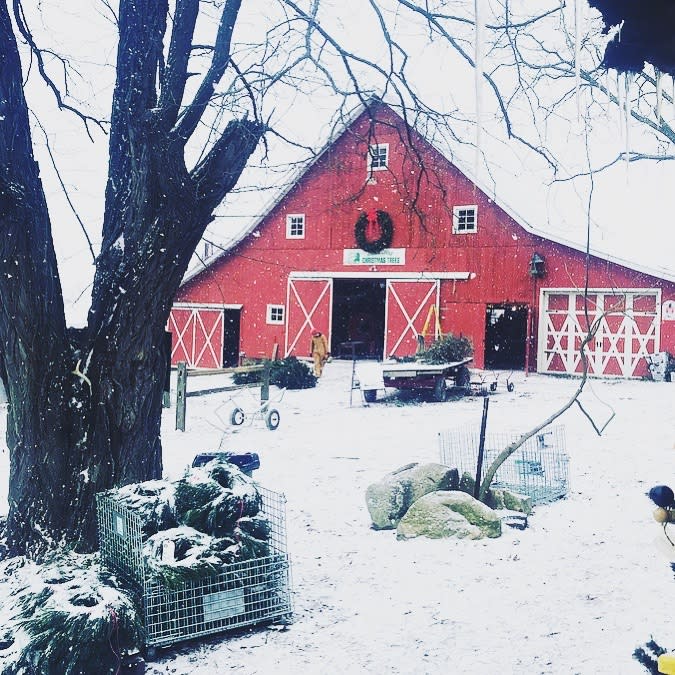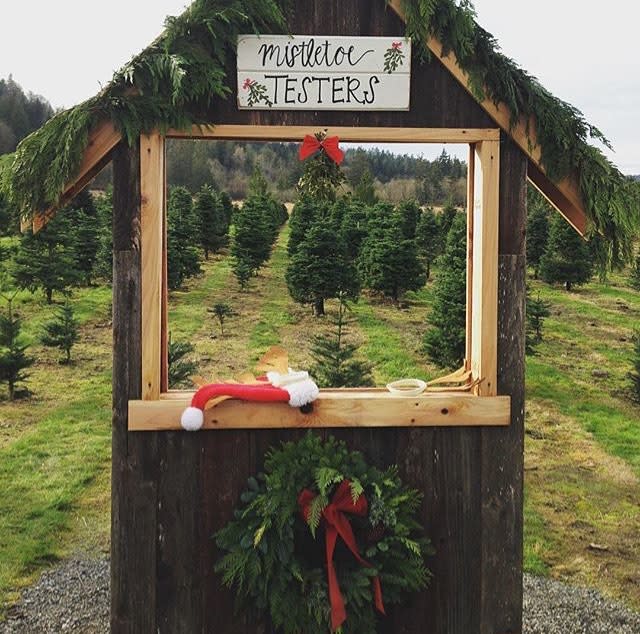Most Americans still buy fake Christmas trees, but the real thing is big on Instagram

About 80% of Americans choose fake Christmas trees over real ones, according to industry data. But among millennials, the generation that prefers experiences over things, the plastic holiday staple has one big disadvantage over its natural competitor. Its journey from a factory in China to the big box supermarket is less Instagrammable than cutting down your own Douglas fir at a local tree farm that might also provide a petting zoo, donuts, and a Christmas-colored sleigh just for your photo-op.
Choose-and-cut Christmas tree experiences are the new apple-picking—a cozy, seasonal experience outdoors, perfect for a friend or young family day trip. Farmers say these outings are more and more popular, and Instagram is filled with tens of thousands of photos with the hashtags #treefarm, #treehunting, #realchristmastree, with people posing with their newly picked specimens, some wielding saws, others small children. A flannel shirt or cozy sweater is a must, although a velvet gown and full suit also make an appearance.
What does the data say?
Whether millennials are starting to tip the scale more in favor of real Christmas trees is up for debate—or perhaps it’s too early to tell. The split between American households buying real and fake trees was about the same in 2013 as it was in 2018, according to data from the American Christmas Tree Association (ACTA), a trade group that advocates on behalf of fake tree manufacturers (although it likes to say it doesn’t want to take sides). Sales of natural trees have remained relatively steady since 2004, and sales of artificial trees have doubled, according to the National Christmas Tree Association (NCTA), which lobbies for real trees.
But there is optimism in the real Christmas tree industry, which has an ongoing “It’s Christmas. Keep it Real” promotional campaign. “We’re certainly seeing a positive trend after years of not seeing the positive trends. So that’s a bit of light at the end of the tunnel,” Tim O’Connor, executive director of the NCTA, said. O’Connor added there’s no hard data on millennial consumers picking natural over artificial, but that NCTA’s member growers have been reporting just that.
“Our sales have increased, I would say, 20, 25 percent from five years ago,” George Richardson, one of the co-owners of Richardson Farm in Illinois, told Quartz while picking up his own tree along with his wife, Wendy. Dana Dull, who manages social media at the Dull’s Tree Farm in Indiana, also said the family farm’s sales have accelerated in recent years. Both farms have healthy choose-and-cut operations, and both are NCTA members.
The millennial appeal
Families turn to fake Christmas trees when their children leave the home, according to O’Connor. Millennials leaving their Baby Boomer parents’ homes was bad news for the real Christmas tree industry. But now, they’re starting their own families, and looking at real trees of their own. Dull said that a lot of their customers are young families, as did the Richardsons.
Opting for a real trees also fits nicely into the millennial ethos. “These are the same people that are driving tremendous growth in organic foods,” O’Connor said. They want to know that the products they purchase are natural and real, the story of how they were produced, he added.
“All of those trends are highly favorable to a real tree that’s grown on a farm owned by a small-to-medium-size business at a local community, as opposed to a tree made from some PVC plastic in China by a big corporation and shipped over on a boat,” he said.
There is debate over which type of tree is the more environmental choice. While the NCTA says there’s no doubt that a real tree is better for the environment, and has support of advocacy groups like the Nature Conservancy, and the Sierra Club, ACTA released a study that argues that because you reuse an artificial tree year after year, it’s the more sustainable choice. There is no simple answer to this question, as Bert Cregg, a forestry professor at Michigan State University, wrote in a post for The Conversation. In terms of carbon footprint, it depends on how many times you re-use the artificial tree, and how far you plan to drive to get your real tree (the environmental impact of both choices is negligible in the end, he says).
The photo opportunity
Dull attributes the rising interest in cut-and-choose experiences in significant part to social media. “People see other people having those experiences, and want to have that same one,” she said.
The farm doesn’t do print advertising, she said, but relies on word of mouth, along with Facebook and Instagram, for promotion. They’ve set up big chairs with the farm logo and trees as the background, an arbor decorated with greenery, and an old tractor, all for that perfect pic. Farms all across the country set up similar experiences, also including shopping and food.
The Richardsons’ farm has a special Snapchat filter. Both use hashtags to promote their business. One of the hashtags for the Dull’s farm is #GrowingMemories.
The hashtag gets to the heart of what this business is about, and what the customers want. Selling trees is one thing, but to have people come back and make new traditions (which is a frequent element of Instagram captions about #treehunting), you need more. It has to be an experience that gets you into the holiday spirit, with the Instagram-ready, mistletoe-adorned, life-size picture frame. For all those young families, the more kid-friendly, the better.
People have taken pictures while doing fun activities about as long as we’ve had cameras, but Instagram adds a performative aspect. Dull said that more recently, she’s seen people be more “artistic-y,” as she put it, about their photos, “more modeling instead of just ‘this is our experience'” snapshot.
A perfect tree-filled backdrop helps more than just farms with their business.
Influencers are cashing in on the #treefarm craze, making their Christmas-themed or just red-accented outfits available to purchase straight from their Instagram photos. Professional photographers love the farms for photo shoots, and Instagram is filled with highly polished family or couples sessions at farms. Engagement photos also abound—Wendy Richardson said there were five engagements on their farm in the two weeks since tree season started.
Kristin Thompson, a lifestyle blogger who writes about living with chronic illness, posted several photos from her tree farm experience, even though she says she can’t have a real tree because of allergies. She picked a farm that had shops, and a little café. She had a fun time with her mom, picking up decorations for their home, and took some photos for her Instagram while she was there, she told Quartz, even though she couldn’t take part in the main activity.
Thompson had a different theory about Instagram’s influence on people’s tree-shopping habits. “I feel like [Instagram] created this culture where you have a fake tree, but go to a tree farm just for pictures or the experience. I see so many fake trees on Instagram today and they’re more popular than ever (flocked trees, different colored trees, etc.),” she wrote in an Instagram message. Indeed, last year, the Wall Street Journal reported there had been a massive rise in white artificial tree sales.
“You can really match it to your personal aesthetic and brand, which is so important to influencers and even just people who enjoy creating and posting to Instagram,” she said. Sometimes #treehunting is not about the tree-shopping at all.
Sign up for the Quartz Daily Brief, our free daily newsletter with the world’s most important and interesting news.
More stories from Quartz:









